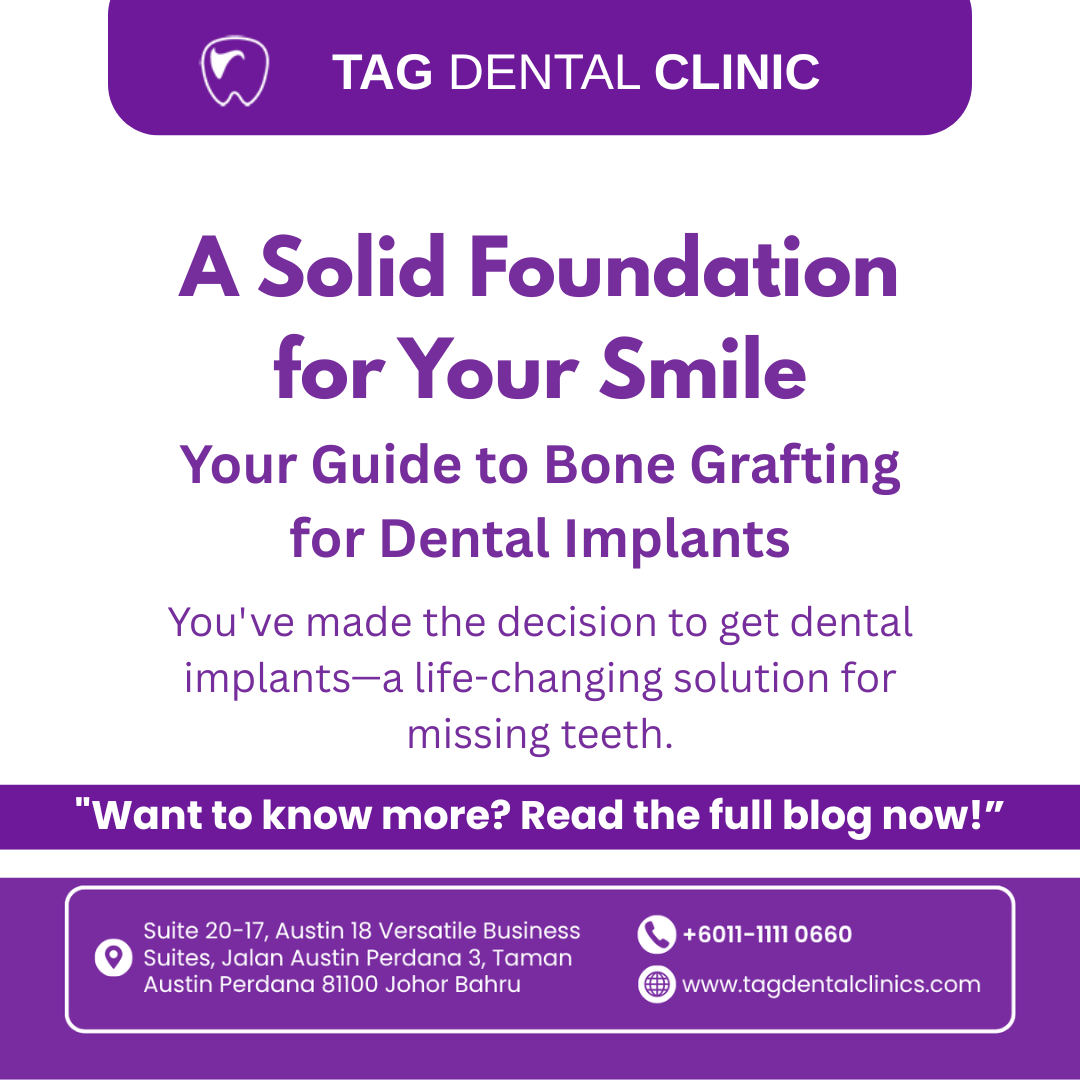Bone Grafting for Dental Implants
Table Of Content

A Solid Foundation for Your Smile: Your Guide to Bone Grafting for Dental Implants
You've made the decision to get dental implants—a life-changing solution for missing teeth. They offer unmatched stability, comfort, and aesthetics. But during your initial consultation, you may have heard a phrase that can sound discouraging: "You don't have enough bone."
Hearing this can feel like a setback, but it's important to know that a lack of jawbone is not a deal-breaker. It's a common issue that our team at TAG Dental Clinic in Johor Bahru addresses with a safe and highly effective solution: dental bone grafting.
This guide will explain why bone grafting is often necessary, how it works, and why it’s a crucial step in ensuring your dental implants have a strong, lasting foundation.
Why Does Jawbone Loss Happen?

Your jawbone is a living tissue that requires stimulation to stay healthy and dense. When you have a full set of teeth, the pressure from chewing and biting transmits through the tooth roots to the jawbone, signaling it to rebuild itself constantly.
When a tooth is lost or extracted, that stimulation stops. Without the regular signals to rebuild, the jawbone in that area begins to resorb, or deteriorate, over time. This process can happen surprisingly fast—within the first year after a tooth is lost, a significant amount of bone density can be lost.
Common causes of jawbone loss include:
- Tooth Extraction: The most frequent cause.
- Periodontal (Gum) Disease: A chronic infection that erodes the bone supporting the teeth.
- Trauma: An injury or accident that damages the jaw.
- Long-term Denture Use: Traditional dentures sit on the gums and don't stimulate the underlying bone, leading to gradual bone loss.
The Role of Bone Grafting in Implant Dentistry

Think of a dental implant as the foundation of a house. Just as a house needs a solid foundation, a dental implant needs sufficient jawbone to anchor it securely. Without adequate bone, the implant may not integrate properly (a process called osseointegration) or could fail in the long run.
Bone grafting is a surgical procedure that adds new bone or bone substitute material to the jaw. This material then acts as a scaffold, encouraging your body to grow new, natural bone over time. This process restores the height and width of the jaw, creating the strong, dense foundation needed for a successful and long-lasting dental implant.
Types of Bone Grafting Procedures: Simplified for You

At TAG Dental Clinic, we utilise a range of advanced bone grafting techniques. Your dentist will recommend the best procedure based on the specific location and amount of bone loss you have.
1. Socket Preservation Graft
- What it is: This is the simplest and most proactive type of graft. It is performed immediately after a tooth is extracted.
- Why it's done: To prevent bone loss before it even begins. By filling the empty socket with bone graft material, we can preserve the bone's width and height, making it ready for an implant in just a few months.
- Best for: Patients who plan to get a dental implant soon after a tooth is removed.
2. Sinus Lift (or Sinus Augmentation)
- What it is: This procedure is necessary for placing implants in the upper jaw, particularly in the molar and premolar regions. The maxillary sinuses are located right above the upper jawbone. When teeth are lost in this area, the sinus floor can expand downwards, leaving very little bone to support an implant.
- Why it's done: The dentist gently lifts the sinus membrane and places bone graft material into the space beneath it. This adds new bone height to the area, creating a suitable site for implant placement.
- Best for: Patients with insufficient bone in the back upper jaw.
3. Ridge Augmentation (or Alveolar Ridge Expansion)
- What it is: This procedure is used when the jawbone is too narrow to hold an implant.
- Why it's done: Bone graft material is placed along the top of the jawbone ridge to increase its width and/or height. This is a common solution for patients who have lost teeth a long time ago and have experienced significant bone shrinkage.
- Best for: Patients with a narrow or thin jawbone ridge.
Frequently Asked Questions about Bone Grafting

We understand you may have questions and concerns about this procedure. Here are some of the most common queries we receive at TAG Dental Clinic.
1. Is bone grafting painful?No, the procedure is not painful. We perform it using local anaesthesia to ensure you are comfortable. For anxious patients, we also offer sedation options. You may experience some mild swelling and discomfort after the procedure, but this is easily managed with prescribed pain medication.
2. How long is the healing process?The healing and integration of the bone graft can take anywhere from three to nine months, depending on the size of the graft and your individual healing capacity. This waiting period is crucial to ensure the graft has fully matured and is strong enough to support the implant.
3. Where does the bone graft material come from?The bone material can be sourced from a few places:
- Your own bone (autograft): This is considered the "gold standard" as it contains living bone cells.
- A donor bank (allograft): Processed human donor bone.
- Animal source (xenograft): Usually from cow bone.
- Synthetic material (alloplast): A man-made, biocompatible material. Your dentist will discuss the best option for your specific case.
Bone grafting is a very safe and routine procedure. The risks are minimal and are similar to any minor surgical procedure, including a small risk of infection, swelling, or nerve damage. We will discuss all potential risks with you in detail during your consultation.
5. How successful is bone grafting?Bone grafting has a very high success rate, typically above 95%, when performed by an experienced professional. This procedure is a well-established and predictable part of modern implant dentistry.
6. Is bone grafting always necessary for a dental implant?No. Bone grafting is only necessary when a patient has insufficient bone to support an implant. A comprehensive 3D scan will determine if you require this procedure.
7. Can I get a crown or temporary tooth during the healing period?This depends on the specific case. In some instances, a temporary crown or bridge can be fitted. If you're using a denture, we can adjust it to be worn safely over the surgical site.
8. What happens if I don't get a bone graft?If you have insufficient bone and do not get a bone graft, it may be impossible to place a dental implant. Attempting to do so would likely result in implant failure.
A Strong Foundation for a Confident Smile
Bone grafting is a crucial and often overlooked step in the dental implant journey. It’s the key to turning a challenging situation into a success story. At TAG Dental Clinic, we believe that a lack of bone should not prevent you from enjoying the benefits of a full, healthy smile. We use the latest techniques and high-quality materials to ensure your implant has the solid, dependable foundation it needs to last a lifetime.
If you've been told you don't have enough bone for implants, don't lose hope. Contact TAG Dental Clinic in Johor Bahru for a consultation. We’ll perform a comprehensive evaluation and create a personalized treatment plan that restores not only your smile but also your confidence.






